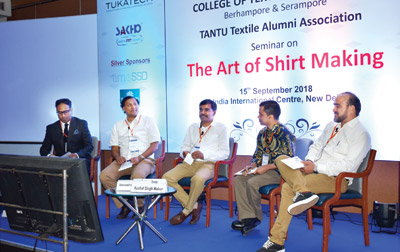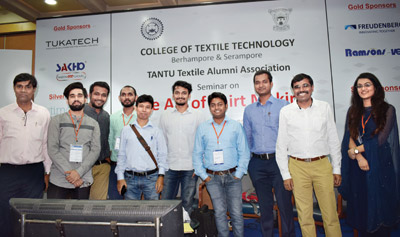The Sixth TANTU seminar on The Art of Shirt Manufacturing was held on September 15, 2018 at India International Centre, New Delhi. There was an exciting gathering of industry experts, academicians, professionals and Govt. officials from all over India and abroad, discussing on the technical and aesthetic aspects considered at the time of shirt making.

(From left) Laszlo, Umesh Gaur, Anshuman Dash, Chandan Saha, Anurag Jaichand, Sunder Belani, Kamaljit Singh
Prabir Jana, President, TANTU and seminar chairman in his brief welcome address, mentioned the seminar theme was chosen based on audience suggestion – the technology of shirt making – the core apparel area. He explained the uniqueness of the TANTU seminar where information & knowledge is extracted from the experts to maximise value to the audience. An interactive seminar where audience also participate in the discussion. The seminar has evolved over the years and this year manufacturing professionals came from Indonesia, Bangladesh, Romania and the US. He also talked about the maiden initiative of TANTU to offer scholarship to two students from its alma mater to attend the annual seminar, which would help students exposing to the newer knowledge and networking with industry professionals.
Keynote speaker, Ram Sareen in his keynote address emphasized the fit of the apparel products and on-demand manufacturing. Through some case studies, he shared how global industry is using technology like 3D simulation and pattern printing to shrink the supply chain lead time and to increase the bottom line. He emphasised how the on-demand garment manufacturing and micro factory will be the future business model.

(From left) Abhishek Tiwari, Sajedur Seraj, Prabir Jana, Raveendra Radhakrishna and Kushal Singh Mahar
The first panel discussion theme was Art of Shirt making and the panel members discussed some of the features and attributes of shirt and its functional and aesthetic aspects. The discussion started with the question on what is the purpose of having a pleat at the across back along with the various types of it. For the aesthetic purpose pleats can be added in various ways one example being stitching a box pleat entirely till the bottom. And for functional purpose it helpsin providing tolerance for movement as well as function as providing fullness along the across back and the waist of the wearer.
After that it was asked about the number of sleeve pleats used in a shirt. More the number or depth of the pleat, more will be the fullness along the biceps and elbow. If a single pleat is used its position should be in the centre of sleeve slit and half-fold of the sleeve. Along with the pleats, the position of the sleeve placket was also discussed where in, it should be always be in the centre of the sleeve opening. Any deviation from that will be a technical fault.
Speakers making presentations at the seminar
-

- Ram Sareen, CEO/Founder, Tukatech
-

- Laszlo, MD, timeSSD
-

- Sri Ramaswamy, Veit Asia Pvt. Ltd.
-

- Anshuman Dash, H&H
-

- Kamaljit Singh, Business Development Manager, Freudenberg India
-

- Prabir Jana, President, TANTU
For the front placket, the question that was asked was that, if there is a relation between width of the placket and the button distance and how this will affect the gaping. It was concluded that if the width of the placket is decreased, the button distance should also be decreased otherwise there will be a higher chance of gaping. Regarding the gaping of top part of buttonhole placket it was concluded an engineered pattern wherein there would be some difference.
Finally, a question was asked to the audience, the reason behind a horizontal button hole for the last (the bottom-most) button of the shirt and the answer was, it has a functional purpose only for a checked shirt where during packing there comes a misalignment of the plackets and the horizontal buttonhole locks the movement of placket.
Kamaljit Singh, Business Development Manager of Freudenberg India, talked about how interlining makes wearers more comfortable wearing a shirt. They have developed for the specific market segment, an application on a white shirt, where they have developed contamination free interlining with the combination of man-made fibre. It has a high washability without risk of delamination and bubbling. In another product Freudenberg comes up with a patented in adhesive technology, it can be withstood in high washability and can be fused with much lower temperature with high-density polyethene. For dress shirt where it needs a firm looks in collar. It has very little weight interlining, they have GSM range varying from 30-105 it makes collar look good not heavy, day-by-day collar are getting softer and it gives ease in collar area, giving the perfect stretch ability.
Laszlo of timeSSD has emphasized the importance of benchmark performance when factories measuring and analysing the productivity and efficiency data. By using timeSSD system, one can easily establish the standard time of sewing operations without prior training. To estimate the standard time Engineer Don’t need to remember code. Engineer just need to choose the correct code depending on the motion, distance and activity.
Anshuman Dash of H&H talked on the technology they use for fusing machine that can be used for variable thickness. He highlighted some of the technical features and parameters of a latest fusing machines. He pointed how the fusing machine productivity can be increased by the same fusing machine without compromising the fusing quality.
The second panel discussion was on technology of shirt making. Panel moderator Prabir Jana started discussion with a video presentation and tried to understand the comparative advantages and disadvantages of alternative methods of sewing various shirt components. What is the common industry practice and what the panellists follow and suggest for stitching different shirt components; collar run stitch, collar fusing, pocket attach, side seaming and fusible tape attaching in sleeve armhole.
Efren Pineda of Laguna clothing says they use ready cutting for collars and interlining instead of stitching and trimming the excess fabric. Fabric is expensive, so why one should trim out the fabric and waste the money by cutting and wasting fabric. They don’t use any zig or profile instead collar run stitch is done manually. All the panellist agreed on that zigs for collar run stitch can be used for mass production. For the all fabric types zig can’t be used. Zig are mostly used in making casual shirts. Further panellist added as the collar shape is not flat, to get the correct collar shape human hand is needed.
 When collar is fused with a fusible interlining, what is best direction feeding collar -is it grain direction, off-grain or diagonal direction? Some panellists suggest collar direction does not matter at all in fusing quality. If all the four fusing parameters are maintained all the time when collar is passing through the machine. Sri from Veit pointed out that diagonal feeding of collars would give better result.
When collar is fused with a fusible interlining, what is best direction feeding collar -is it grain direction, off-grain or diagonal direction? Some panellists suggest collar direction does not matter at all in fusing quality. If all the four fusing parameters are maintained all the time when collar is passing through the machine. Sri from Veit pointed out that diagonal feeding of collars would give better result.
What is correct way of attaching the chest pocket in the front panel? Almost all panellist agreed in starting pocket stitching from front placket side as it would easier for aligning pocket and matching patterns. In practice some shirt makers start sewing pocket from the side seam. Why so? Jana answered the questionanti- clock wise rotation of a garment component while stitching is natural motion. Following that natural habit of human, pocket stitching should be started from armhole side.
Sri Ramaswamy of Veit enriched audience by sharing the garment fusing technology and the possible solutions of many common problems we face during fusing garment components. He further emphasized how the Veit fusing machine can help in reducing unnecessary power consumption when the machine is not in use. A control panel ensures the fusing machine only runs when machine temperature reach to the desired level to achieve the best fusing quality in all garments. Fusing machine records breakdown time and maintenance time.
The final panel discussion on “the business of shirt making” started focusing on the matter, that how in spite of India’s excelling in fabric, garment production and technology, it has not come up as a prominent place in shirt making industry and how the change in market dynamics from large orders to small orders with various fashion elements have affected the industry.
In reply to that the most prominent answer did not came in favour of India’s production as from the beginning there has been a lag in interest in shirt making. Adding to that, most of the manufacturers don’t have that level of commitment to the buyers and then comes the costing. In present day it has become like impossible to compete with the costing provided by Bangladesh’s manufacturers.
Roopak Malik, Director, Textile Sourcing Limited totally blamed the delivery system of orders along with the costing. Gaurav Kumar, Marketing Director of Aquarelle added the problem with the mind-set of the export house where in they think of only individual order profit and not think of having a long-term relation with the buyer. Mridul Dasgupta, GM of Macy’s merchandising group believes that value addition and design driven production is India’s strong hold and no other country can compete with India. It was also discussed about the problems faced by the Indian manufacturers in scaling up the production system for shirts. Along with that, Pallab Banerjee, Strategic Advisor of Pearl Global also discussed about strategic sourcing and what advantages it may upon its implementation.
Thus, in conclusion, we have missed the chance of becoming a very strong textile value chain but with product development, change of mind set we can make a mark in this business and again it will not be possible without proper commitment from the industries, but then again lies the big question “Do we really want to get into business of shirt making?”














